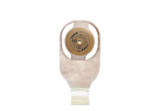1-Piece Ostomy Bags
One-piece ostomy bags are all-in-one systems designed for convenience, discretion, and ease of use. With the wafer and pouch combined into a single unit, one-piece ostomy systems are a great option for new ostomates and people looking for a low-profile solution.
One-piece ostomy bags are all-in-one systems designed for convenience, discretion, and ease of use. With the wafer and pouch combined into a single unit, one-piece ostomy systems are a great option for new ostomates and people looking for a low-profile solution.
What Is a One-Piece Ostomy Bag?
A one-piece ostomy bag combines the skin barrier (wafer) and the pouch into a single unit. Unlike a two-piece system, you don’t need to buy separate parts or worry about compatibility. Simply attach the entire appliance directly to your skin, and you're ready to go.
Benefits of One-Piece Ostomy Systems
- Simple application: No assembly required
- Lower profile: Less visible under clothing
- Fewer leaks: No gaps between wafer and pouch
- Ideal for beginners: Easier to learn and use
Bag Styles: Drainable vs Closed-End
We carry both drainable and closed-end one-piece ostomy bags. Drainable pouches have an opening at the bottom, allowing you to empty waste without removing the pouch. Some use built-in closures like Velcro, while others require a separate clip, available in our ostomy accessories.
Closed-end pouches are fully sealed. When full, you simply remove and replace the pouch. This makes them a convenient choice for outings or quick changes in public settings.
Wafer Options for a Custom Fit
Even though the wafer is built in, you still have options:
- Pre-cut: Ready to use, best for uniform stomas
- Cut-to-fit: Trim to your shape for a better fit
- Moldable: Flexible and snug without scissors
Flat vs Convex One-Piece Wafers
Convex wafers curve inward to apply gentle pressure around the stoma, helping it protrude. This creates a better seal and reduces leaks for those with flush or recessed stomas. Choose from standard flat wafers or a range of convex options. Always consult your ostomy nurse before switching to a convex system.
Make Removal Easy with Adhesive Removers
Because one-piece bags must be removed completely during changes, using an adhesive remover can protect your skin. We offer sprays, wipes, and liquid removers to gently lift the wafer without pain or damage.
Explore our full selection of one-piece ostomy bags in multiple sizes, shapes, and styles to fit your lifestyle. Whether you prefer the simplicity of closed-end pouches or the flexibility of drainable ones, Express Medical Supply has what you need.



